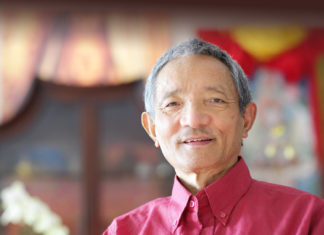This is talk five from a 1974 Naropa course entitled: Meditation, The Path of the Buddha
Summary of Talk Five: The Dawn of Enlightenment
Study Guide
prepared by Carolyn Gimian
Original date of the talk: July 8, 1974
Overall Length: 58 min.
All of these talks are experiential. In the last talk, Chögyam Trungpa gives the audience a taste of the desolation and power of shunyata or emptiness and how this experience leads to the dawning of buddha nature and the first glimpse of enlightenment.
Ground: In an ordinary sense, mind functions to try to prove our existence, but in reality, mind doesn’t exist and the phenomenal world is not there, and we function on the level of non-existence.
- We assume that we exist and that we can manipulate our world, as if the world is made up of flexible, yielding phenomena. This is a big problem.
- Actually, the phenomenal world is not there. It is up to us to explore the possibility that the phenomenal world doesn’t exist. If you are really brave, you can look into your own non-existence as well. But since that’s very threatening, we can start with the non-existence of the environment.
- There’s no territory, there’s no maker of the universe, and no organism that takes care of you or will destroy you. We can experience and explore this on the phenomenological level, through the practice of meditation.
- Through practice, we may find that we are dancing with space, but what is space? We experience space purely from the point of view of boundary, or reference point.
- In reality, trying to explore non-existence is trying to do the impossible. Why are we questioning or exploring this at all? We don’t know. We have to accept the nonsense, uncertainty, confusion and being at a loss.
- Understanding that there is nothing to understand is the dharma, the truth, of the situation.
Path: Once we realize that there is nothing to understand, we begin to sense the environment, the empty ground and empty space in which the dawn of enlightenment can take place. This experience is the beginning of realizing shunyata, or emptiness.
- When we stop looking for understanding and we don’t even try to be, we begin to experience an enormous vacuum or space. The dawn of enlightenment cannot take place without that sense of desolation and meaninglessness to begin with.
- Then, you begin to experience the dawn or glimmer of light, which in Western language is called the Star of Bethlehem. A birth of something is taking place. There’s a star in the deep black midnight sky.
- The practice of meditation and awareness is based on that experience of vacantness or non-existence. Within that, we experience emotions and fantasies of all kinds, which are merely expressions of that dawn of enlightenment.
- Having understood that there’s no self, the dawn of enlightenment occurs. You can work with your awareness. Unreality has created a reality at that point. Such experience is called shunyata, or emptiness. The whole thing is empty, non-existent; therefore, it does exist by itself.
Fruition: Out of the sense of loneliness and desolation, we may become an enormously powerful hero or samurai. Having seen the dawn of enlightenment, you begin to express tathagatagarbha or buddha nature. However, our life is still desolate and empty.
- It’s painful to discover the truth of non-existence and to experience the loneliness on top of that. We might twist that into thinking that nonexistence means we won’t have to feel anything or we can become one with things, to get rid of the pain.
- Instead, you begin to experience another Star of David. A beautiful, extensive desert arises out of desolation and darkness. Above that desert, you see a star in the sky that looks down on you and mocks you, telling you the truth of your state of being, which is further pain and desolation.
- This sense of shunyata can only be realized through the sitting practice of meditation and the vipashyana experience. You begin to realize that even the techniques you’ve used in your practice are a con. You find yourself sitting, doing absolutely nothing, completely ripped open and naked.
- However, you don’t disappear; you are unable even to die. Instead there is a brave and powerful state of existence that doesn’t want to give up or give in, although it’s lost its reference point completely. This is the discovery of tathagatagarbha or buddha nature.
- When you experience the true sense of aloneness, you discover that the entire cosmos, the universe, is absolutely empty. It doesn’t help you or keep you company. Such utter loneliness becomes companionship.
- When you experience the true sense of aloneness, you discover that the entire cosmos, the universe, is absolutely empty. It doesn’t help you or keep you company. Such utter loneliness becomes companionship.
- You don’t get a reward or get better by practicing meditation. The truth is this desolation and realizing that a further dissolving process is necessary.
Audience Question and Answer
- If all we have in store is further desolation, why do we keep sitting?
- Where does the action of the Bodhisattva come into all this?
- After you experience aloneness, what’s left?
- Is there such a thing as grace in the Buddhist tradition?
- Will I have a teacher in my head until I become fully conscious?
- What do you think about the hermit tradition?
- Is it important to read about shunyata as well as to experience it in practice?
- You seem to be emphasizing the form is emptiness and emptiness is form aspects of shunyata. What about form as form and emptiness as emptiness?
- When you speak of non-existence, what existence is there to compare it to?
- Is there a correlation between shunyata and the fourth moment?
- This class was great at first. Now it’s very painful. Doesn’t some meaningfulness exist in the relationship of us being here, even if nothing exists?
- If we’re totally alone, how do we take refuge in the Buddha?
- Is non-existence more like a dream or a vacuum?
Suggested Readings:
Recommended: “The Star of Bethlehem,” pages 35 to 52, from The Path Is the Goal: A Handbook of Buddhist Meditation.
Alternate: “Loneliness”, pages 126 to 144, from The Path Is the Goal: A Handbook of Buddhist Meditation.
Optional: “Creating a Little Gap,” pages 145 to 153, from The Path Is the Goal: A Handbook of Buddhist Meditation.
















